Top 10 Must-Visit Destinations in the UK
The United Kingdom is often associated with iconic landmarks like Big Ben and the Queen’s Guards, but it offers much more. From historic cities and coastal towns to medieval sites and picturesque countryside, the UK presents a rich and diverse travel experience. Whether interested in history, nature, or vibrant urban life, travelers will find something exceptional across the country.
Planning to Visit the UK? Here’s How You Can Get There
To travel to the United Kingdom and explore its top 10 destinations, you must obtain an approved UK Electronic Travel Authorisation (ETA). The UK ETA provides a secure and convenient way to enter the country without unnecessary delays. Here is how you can apply for your UK ETA.
- Enter details and upload documents: Begin the UK ETA Application process by providing all necessary personal information, including your full name, email address, and passport number. Upload the required documents, which include a recent passport-sized photograph along with scanned copy of the passport’s bio-data page.
- Check form, then submit: Carefully review the UK ETA application form to ensure that no information or documents are missing or incomplete. Any omissions may result in delays in the processing of your application.
- Complete payment, await approval:Complete the payment using any major credit or debit card and wait for the approval. Please note that the approval process may take some time.
Top 10 Must-Visit Destinations in The UK
1. London Tower
The Tower of London is one of the United Kingdom’s most enduring symbols, with a history that goes back more than a thousand years. Built initially as a military fortress, it later became a royal home and, over time, gained infamy as a prison. English monarchs governed from this stronghold, using it to assert their control and leave a lasting influence on the nation’s development.

Today, the Tower opens its gates to visitors eager to explore its past. Inside, you’ll find the priceless Crown Jewels on display, the remains of the once-operational Royal Mint, and an extensive collection of historic armour, including pieces worn by King Henry VIII. You can also meet the Yeoman Warders, who have served as guardians of the Tower for generations, and see the famous Ravens, long thought to be protectors of the fortress itself.
Reasons to Visit The London Tower
The Tower of London is one of the city's oldest and most historically significant landmarks, with its origins dating back to the completion of the White Tower in 1086. William the conqueror commissioned its construction to assert royal authority, and over time, the tower served various roles, including a royal residence, a prison, and a place of execution. It became the site of many pivotal events and held notable prisoners such as Anne Boleyn, Lady Jane Grey, and John Frith—individuals who were often detained not for crimes, but because of religious convictions or political associations.
Visitors today can explore this complex and powerful history through guided tours led by the Yeoman Warders, as well as through the detailed displays and memorials placed throughout the site.These resources shed light on the personal experiences of those once imprisoned within its walls and help visitors reflect on the broader political and religious conflicts that defined different eras of the monarchy.
Let us explore some remarkable facts about the Tower of London, along with a few intriguing historical mysteries associated with it.
- The Tower of London Is Not Its Official Name
The site commonly known as the Tower of London is officially titled 'Her Majesty’s Royal Palace and Fortress of the Tower of London. - The Tower Was Once London’s First Zoo
Before housing prisoners, the Tower kept exotic animals gifted to royalty, forming London’s first zoo known as the Royal Menagerie. - The Crown Jewels Rest Securely Inside the Tower
Since the 15th century, the Tower has protected the Crown Jewels, including the imperial state crown with over 23,000 gemstones. - The Beefeaters Have Guarded the Tower for Centuries
The Yeoman Warders, or Beefeaters, have served as ceremonial guards since the 16th century and were once responsible for prisoners and the crown jewels. - Ravens Are Royal Guardians of the Tower
Royal superstition keeps ravens at the Tower, as legend warns the monarchy would fall if they ever left. A Ravenmaster cares for them daily. - The Ceremony of the Keys Takes Place Every Night
Every night at 9:53 p.m., Yeoman Warders lock the gates in a tradition known as the ceremony of the keys, unchanged for over 700 years.
2. British Museum
The British Museum came into existence in 1753 and welcomed the public for the first time in 1759. It was the earliest national institution to offer insight into every major area of human knowledge, inviting visitors from around the globe.
From the start, the museum reflected the spirit of the enlightenment, encouraging open discussion, rational thinking, scientific discovery, and the pursuit of progress through tolerance.
It holds a strong belief in the value of material objects as lasting evidence of human civilisation. These items help tell the story of cultures, beliefs, and historical developments.
Ongoing research and learning remain central to its mission. The Museum actively works to increase understanding and share its findings with people worldwide.
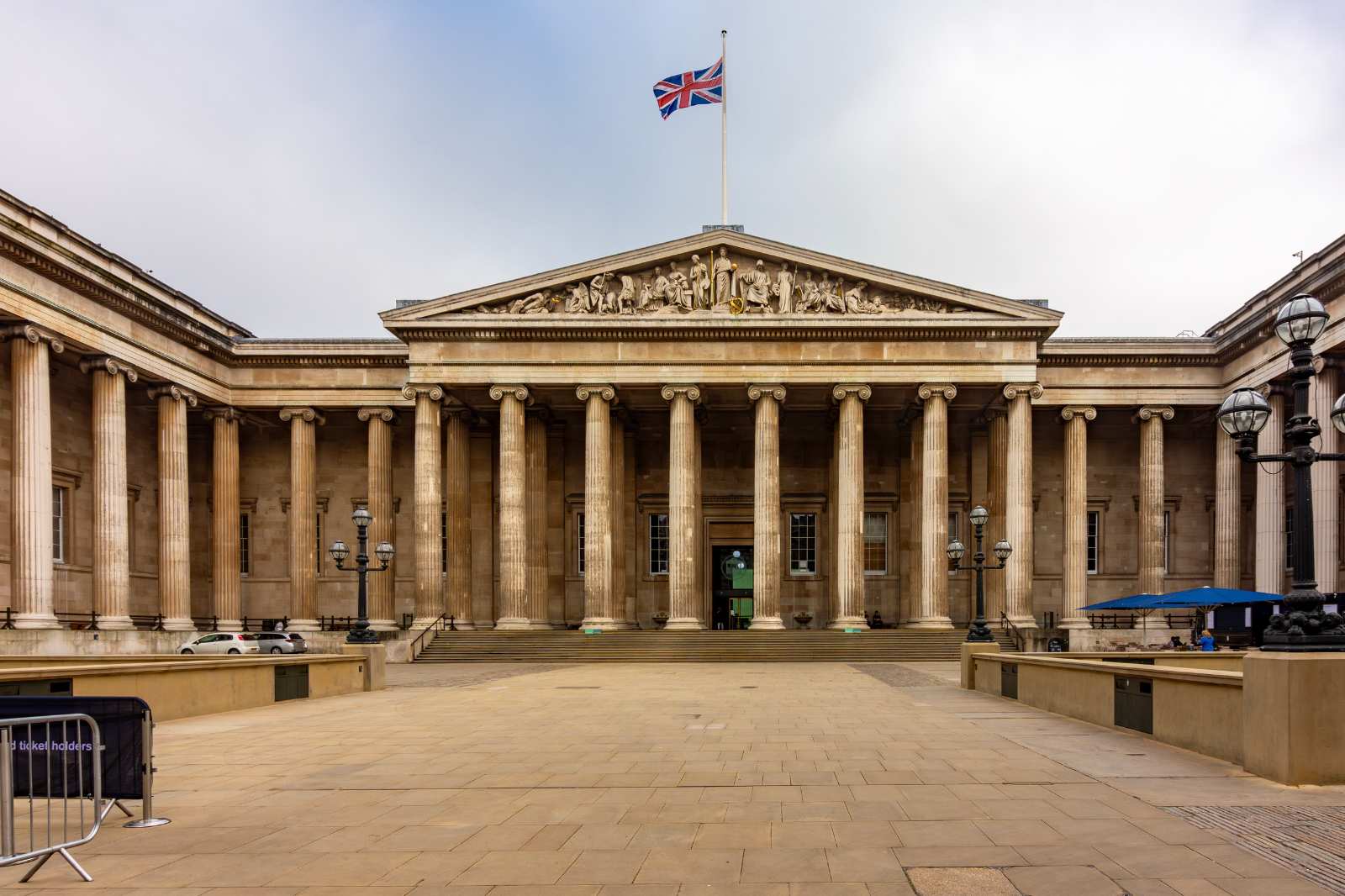
The British Museum in the Modern Era
The British Museum continues to develop while honouring its origins. In 2001, it introduced the Great Court, built around the original Reading Room.
The museum no longer holds natural history items or literary collections. These now belong to the Natural History Museum and the British Library, both of which operate independently. Still, the Museum maintains its global focus through artefacts from ancient and modern cultures.
The original 1753 collection has grown significantly. Today, the British Museum holds over 13 million objects, while the Natural History Museum and the British Library hold 70 million and 150 million items respectively.
Architect Sydney Smirke designed the Round Reading Room in the 19th century. It served scholars for nearly 150 years. After the national library moved in 1997, the space was later transformed into the Walter and Leonore Annenberg Centre.
Must-See at the British Museum
The British Museum houses an estimated 8 million objects and spans an area of 1 million2 feet, making it one of the largest and most comprehensive collections of art and antiquities in the world. Given the scale and diversity of its exhibits, it is advisable to explore the museum with an English-speaking guide who can offer context and interpretation to enhance the visitor experience.
The Egyptian Room at the British Museum presents a distinguished collection, including ancient mummies, sphinxes, and the renowned rosetta stone, which played a pivotal role in the translation of Egyptian hieroglyphics. In Room 41, visitors can view the Sutton Hoo ship burial, unearthed in 1939, which remains one of the most significant archaeological discoveries in British history.
What You Might Not Know?
The British Museum holds centuries of history, yet many of its most fascinating stories remain lesser known. Below are a few surprising facts that highlight the Museum’s unique past and enduring legacy.
- Older Than the USA.
Since 1759, the British Museum has been open to the public, 17 years before the United States declared independence in 1776. - The Museum Had a Tube Station.
The British Museum operated a dedicated tube station from 1900 until its closure in 1933, just before Holborn station opened nearby. - Cat Guarded the Gate.
From 1909 to 1929, a cat named Mike guarded the main gate of the museum and became so well known that major newspapers published his obituary. - Buckingham Palace Almost Chosen
Before choosing Montague House for its location, the trustees considered establishing the museum at Buckingham House, which later became Buckingham Palace. - Birth of Two Institutions.
Due to the growing size of its collections, the British Museum established the Natural History Museum in the 1880s and the British Library in 1973. - Early Use of Electric Lighting.
The British Museum began experimenting with electric lighting in 1879 and expanded its use throughout the galleries within a decade. - Collection Evacuated in WWII.
In 1939, the British Museum began evacuating its most valuable objects. While many items were saved, bombing during the war destroyed around 250,000 books.
3. Buckingham Palace
In 1703, the Duke of Buckingham commissioned the building that would later become Buckingham Palace. Since 1837, it has served as the principal residence of the British monarch. Today, it functions as the monarchy’s administrative centre and hosts key royal ceremonies and official receptions.
The palace is globally recognised as the monarch’s residence and a central site for national ceremonies, including the changing of the guard.
The State Rooms are open to visitors from 10th July to 28th September 2025. Guided tours, including access to the east wing, run on selected dates from January to May 2025.
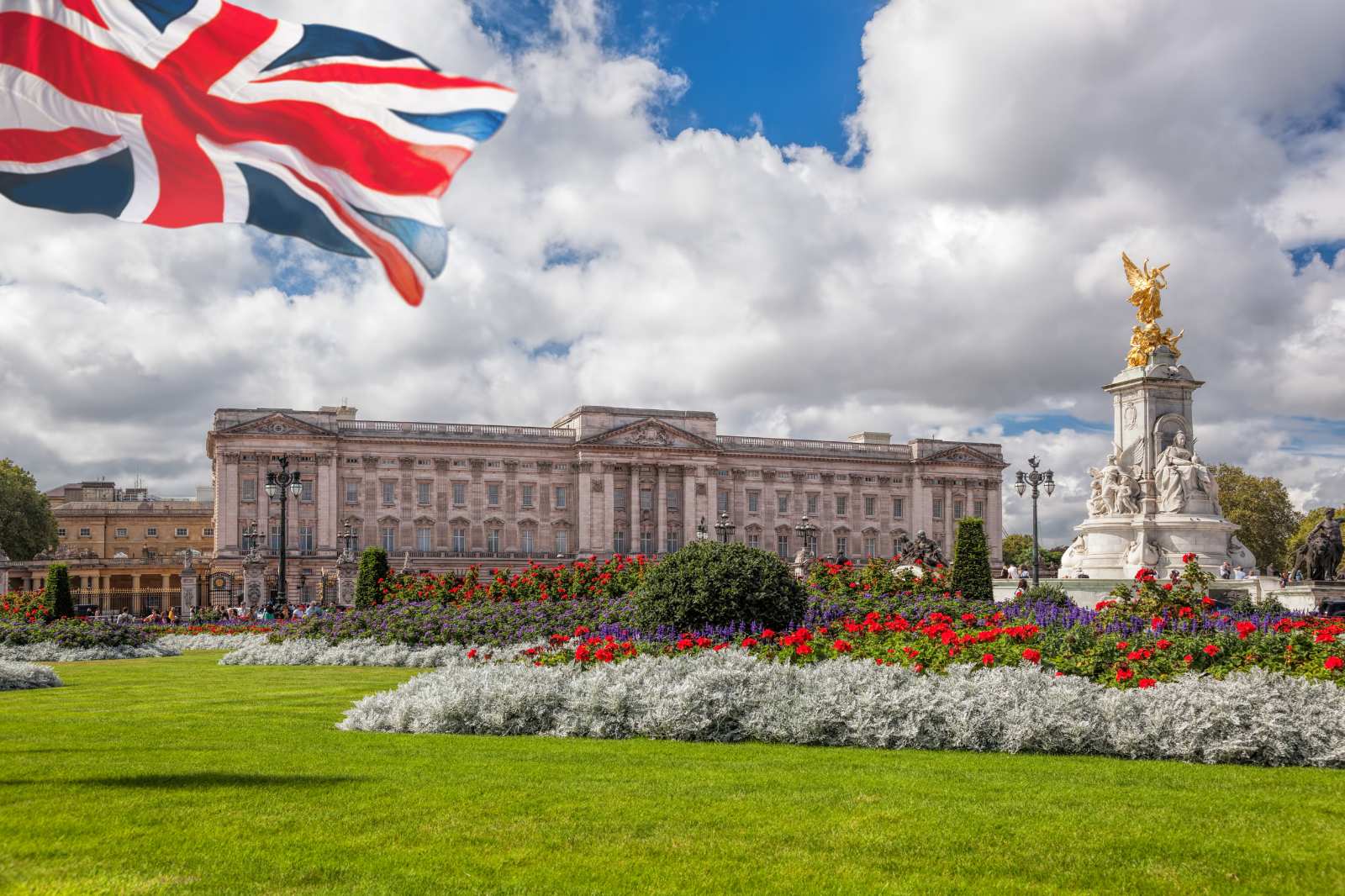
🕰️ Buckingham Palace Opening Hours (2025)
|
Visit Dates |
Opening Time |
Last Admission |
Closing Time |
|
10 July – 31 August 2025 |
🕤 9:30 AM |
🕠 5:30 PM |
🕢 7:30 PM |
|
1 – 28 September 2025 |
🕤 9:30 AM |
🕟 4:30 PM |
🕡 6:30 PM |
What Makes Buckingham Palace Worth Visiting?
Buckingham Palace began as Buckingham House, a grand residence constructed in the early 1700’s for the Duke of Buckingham. In 1761, King George III selected it as a private home for Queen Charlotte, marking the start of its transformation into a royal residence. This rich historical background makes it an important site for those interested in British heritage and royal tradition.
Today, the palace features 775 rooms, including royal apartments, staff quarters, and lavish staterooms used for official ceremonies and state functions. It has 760 windows that are cleaned regularly and is illuminated by more than 40,000 light bulbs. Visitors can admire not only the architecture and scale of the palace but also its continued role as a working royal residence.
Buckingham Palace: Notable Facts
- Built for a Duke
In 1703, the Duke of Buckingham commissioned the construction of Buckingham House, which King George III later acquired in 1761. Queen Victoria designated it the monarch’s official residence in 1837.
- Teenager Breached Security
Between 1838 and 1841, Edward Jones trespassed into Buckingham Palace multiple times, stealing food and even items from Queen Victoria’s room. His actions later inspired copycat incidents, including one in 1982.
- Hit During World War II
Buckingham Palace suffered nine direct bomb strikes during the 2nd world war. Despite the risk, King George VI and Queen Elizabeth chose to remain in the palace throughout the war.
- A Self-Contained Estate
Covering 39 acres, the palace includes facilities such as a post office, cinema, clinic, and police station. It contains 775 rooms, including bedrooms, offices, and staterooms.
- Hosted Girl Guides
Between 1937 and 1939, Princess Elizabeth and Princess Margaret led Girl Guide meetings at the palace, forming the 1st Buckingham Palace Girl Guide Company with over 30 girls.
- Built from Fossil-Rich Stone
The palace was constructed using oolitic limestone, a rock containing the fossilised remains of tiny marine organisms believed to be over 200 million years old.
- First US Presidential Visit
In December 1918, President Woodrow Wilson became the first sitting American president to visit Buckingham Palace, strengthening US–UK relations with a formal banquet hosted by King George V.
- Queen’s Sandwich Parties
Queen Elizabeth II hosted large summer garden parties at the palace, where guests consumed over 20,000 sandwiches, along with specially blended tea and cakes.
- Flag Signals Queen’s Presence
When the royal standard flag flew above Buckingham Palace, it signified the Queen was present. The Union Jack indicated her absence, often due to stays at Windsor Castle.
- Guards Wear Red Uniforms
The royal guards wear red because it was the most affordable dye when the uniforms were introduced. The colour also symbolises strength, authority, and national tradition.
4. Edinburgh Castle
Edinburgh Castle stands on a prominent rocky hill and has served as a royal residence, military fortress, garrison, and prison throughout its long history. Its strategic location was first recognised during the Iron Age, and it played a crucial role in historic conflicts, including the Wars of Independence.
Today, while parts of the castle still serve military purposes, it stands as a world-famous attraction and forms a central part of Edinburgh’s UNESCO World Heritage Site. Visitors walking up Castle Hill trace the path of kings, soldiers, and historic figures through centuries of Scottish history.
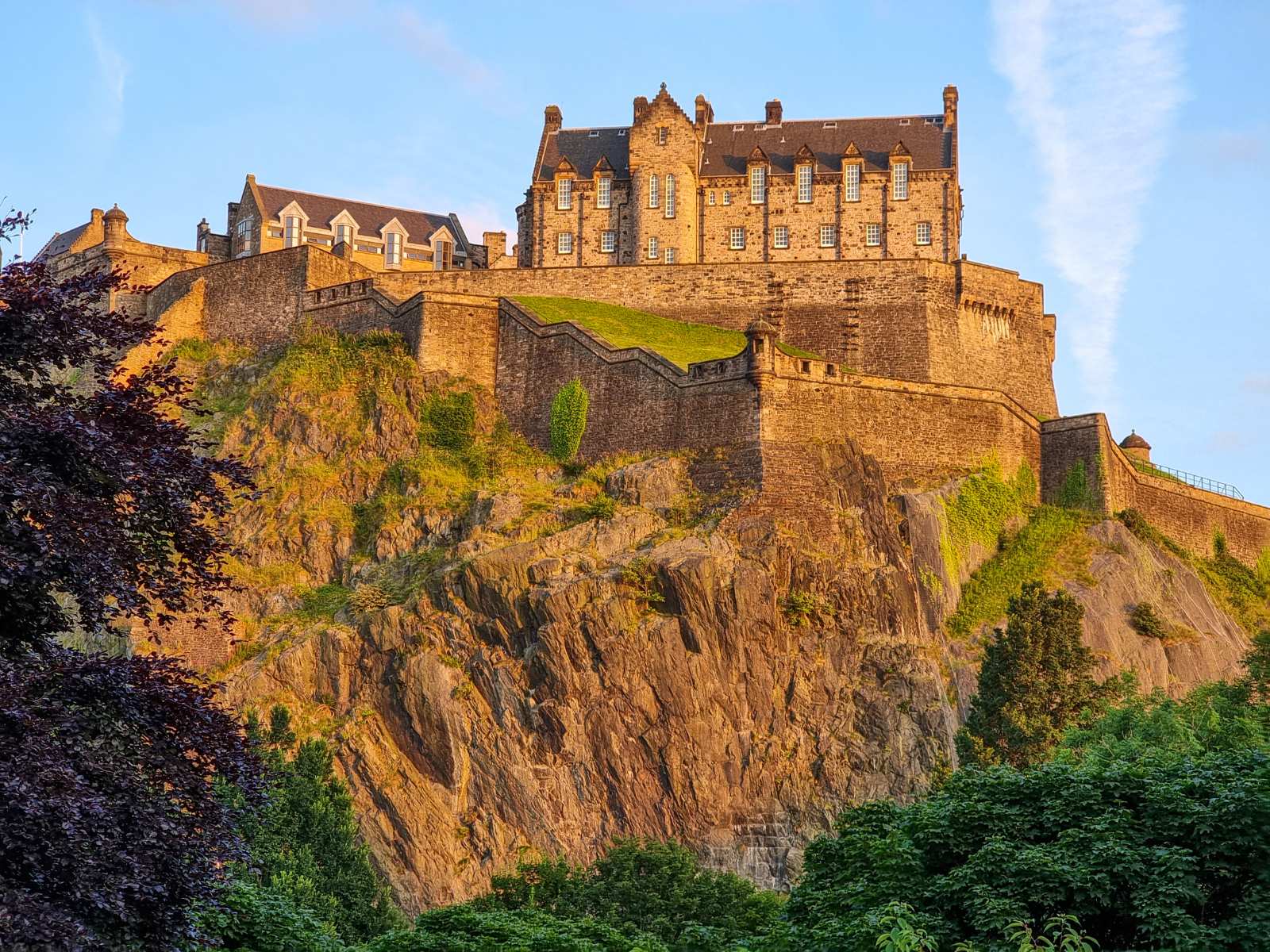
What awaits at Edinburgh Castle?
Edinburgh Castle, set high on a rugged hill, offers striking views and reveals why it was nearly impossible to conquer. A walk up the royal mile enriches the visit with historic surroundings and a peaceful atmosphere. Inside, visitors can view the Scottish crown jewels and the historic stone of destiny, both central to royal coronations. The castle also features a vivid prisons of war exhibit, recreating conditions from the 1800s when captives were held beneath the Great Hall.
Interesting Facts About Edinburgh Castle
- Britain’s Most Besieged Fortress.
Edinburgh Castle has faced more sieges than any other site in the United Kingdom, making it a focal point of conflict throughout the nation's history. - Captured in Thirty Minutes
In 1639, Covenanter forces under General Alexander Leslie successfully captured the castle in just thirty minutes. - A Failed Jacobite Attempt
During the Jacobite Rising of 1715, an attempted capture of the castle failed due to poor planning. The ladder intended to scale the ramparts was too short. - The Crown Was Hidden in Wartime
In the 2nd world war, authorities hid the Crown of Scotland in David’s Tower by burying it inside a mediaeval latrine closet to protect it from enemy forces. - Scotland’s First Fireworks Display
In 1507, Edinburgh Castle hosted Scotland’s first recorded fireworks display during a jousting tournament organised by King James IV. - A Royal Treasury.
The castle once served as a royal treasury, safeguarding national records, valuable jewels, relics of Robert the Bruce, luxurious tapestries, and items believed to hold magical powers. - The Birthplace of Ordnance Survey
In 1747, military surveyor William Roy began his cartographic work at the castle. His efforts laid the groundwork for the creation of Ordnance Survey, the UK’s national mapping agency. - A Wartime Military Hospital
In 1939, the castle's military hospital treated luftwaffe pilots who had been shot down over the Firth of Forth after they were brought to the site. - A Daring Escape in 1811
In 1811, forty-nine French prisoners of war escaped by cutting a hole in a castle wall and lowering themselves down the south crag using ropes. Only one man failed to get away.
5. St Paul’s Cathedral
St Paul’s Cathedral, known formally as the Cathedral Church of St Paul the Apostle, serves as the main Anglican cathedral in London and the official seat of the Bishop of London. Located on Ludgate Hill—the highest elevation within the historic City of London—it has stood as a key religious centre since the early 7th century.
The present-day cathedral reached completion in the year 1710, following a major reconstruction led by Sir Christopher Wren. It replaced the earlier gothic cathedral destroyed in the great fire of 1666, which had served as a major hub of worship and public life in mediaeval London.
Today, St Paul’s Cathedral is one of the city’s most iconic buildings. Its dome rises 365 feet and remained the tallest feature on London’s skyline for centuries. It continues to attract visitors for both its spiritual importance and architectural grandeur.
🕰️ St Paul’s Cathedral Sightseeing Hours.
|
Day |
Opening Time 🕘 |
Last Entry 🕓 |
Closing Time 🕟 |
|
Monday |
🕣 8:30 AM |
🕓 4:00 PM |
🕟 4:30 PM |
|
Tuesday |
🕣 8:30 AM |
🕓 4:00 PM |
🕟 4:30 PM |
|
Wednesday |
🕙 10:00 AM |
🕓 4:00 PM |
🕟 4:30 PM |
|
Thursday |
🕣 8:30 AM |
🕓 4:00 PM |
🕟 4:30 PM |
|
Friday |
🕣 8:30 AM |
🕓 4:00 PM |
🕟 4:30 PM |
|
Saturday |
🕣 8:30 AM |
🕓 4:00 PM |
🕟 4:30 PM |
|
Sunday |
❌ Closed |
❌ Closed |
❌ Closed |
|
Pro Tip: Times are subject to change. Always check the official calendar for updates before your visit. |

St Paul’s: A Must-See in London
St Paul’s Cathedral, with its iconic dome, stands as a defining feature of London’s skyline. The Cathedral invites visitors for worship, sightseeing, and cultural events, including orchestral performances and public discussions.
Daily services are open to all and feature music by the cathedral choir and other talented musicians. These moments of worship provide an opportunity for reflection in a setting rich with history and tradition.
Sightseers can explore the cathedral floor, visit the crypt where notable figures are buried, and climb 528 steps to enjoy panoramic views from the dome. The Whispering Gallery and the many chapels throughout the cathedral offer further points of interest during the visit.
Secrets of St Paul’s Cathedral
- Rich Art Collection
The cathedral houses artwork from different eras, including Victorian mosaics, modern sculptures, and contemporary installations. - Wren’s Burial Site
The cathedral’s designer, Sir Christopher Wren, became the first person to be buried within its crypt following his death in 1723. His latin epitaph invites visitors to view the building as his true monument. - Famous Burials and Memorials
St Paul’s honours many national figures, including Admiral Nelson, Sir Alexander Fleming, and poet John Donne. Others like Florence Nightingale and Winston Churchill have memorials or funeral connections. - Film and Artistic Icon
Artists and filmmakers have featured the cathedral in works ranging from canaletto’s paintings to major films like Harry Potter and Sherlock Holmes. - Suffragette Incident
In 1913, suffragettes attempted to bomb the bishop’s throne. The device failed to detonate but remains a symbolic act in the history of women’s rights. - Modern Art Exhibits
Temporary exhibitions by artists like Yoko Ono and Anthony Gormley continue to bring contemporary perspectives into the cathedral. - Royal Weddings
St Paul’s Cathedral served as the setting for the 1981 wedding of Prince Charles with Lady Diana, a royal event that received worldwide coverage.
6. Tower Bridge
Tower Bridge holds a distinctive place in London’s skyline and stands as a historic symbol of the city’s architectural and engineering heritage. Completed in 1894, it connects the boroughs of Tower Hamlets and Southwark across the River Thames. Its design complements the nearby Tower of London, with twin towers rising 61 metres and supporting high-level pedestrian walkways.
The bridge spans approximately 240 metres, with a central bascule section that opens 76 metres wide to allow ships to pass. Originally, the upper walkways allowed pedestrians to cross while the bridge was raised, but misuse led to their closure in 1910. They reopened to the public in 1982 as part of the Tower Bridge Exhibition.
Today, Tower Bridge is open to visitors 363 days a year. Guests can explore its Victorian engine rooms, learn how the bridge operates, and enjoy panoramic views of the city from 42 metres above the river. It remains a proud symbol of London’s industrial and architectural heritage.

🕰️ Tower Bridge Opening Hours
|
Day/Date |
Opening Time 🕤 |
Last Entry 🕔 |
Closing Time 🕕 |
|
Daily (general admission) |
🕤 09:30 AM |
🕔 05:00 PM |
🕕 06:00 PM |
|
2nd Saturday each month (relaxed) |
🕤 09:30 AM (relaxed) |
🕚 11:30 AM (relaxed ends) |
🕕 06:00 PM (General entry resumes after 11:30) |
|
24–26 December |
❌ Closed |
❌ Closed |
❌ Closed |
|
1 January |
🕙 10:00 AM |
🕔 05:00 PM |
🕕 06:00 PM |
What Makes Tower Bridge Unique?
Tower Bridge is a distinguished example of victorian engineering. Constructed over eight years by hundreds of workers, it combined practicality with design, using vast amounts of steel, brick, and rivets. Its neo-Gothic style continues to make it one of London’s most recognisable landmarks.
Although used daily by thousands, the bridge still gives priority to river traffic. It opens around 850 times annually, maintaining its original purpose. Even high-profile individuals have waited as ships passed through, reflecting the bridge’s ongoing operational role.
Since its opening in 1894, Tower Bridge has stood as a functional and symbolic feature of the city. Once the most advanced bascule bridge in the world, it remains a celebrated icon of London’s heritage and innovation.
Fascinating Details About Tower Bridge
- A Young Landmark
Opened in 1894, Tower Bridge is much younger than nearby sites like the Tower of London. Its Gothic appearance masks a strong steel framework. - Designed After a Competition
Over 50 designs were submitted before Sir Horace Jones and Sir John Wolfe Barry’s proposal was approved in 1884. - Built with Skill
Construction took eight years and involved thousands of tonnes of materials and over 13 million rivets. - Not a Drawbridge
Unlike traditional drawbridges, Tower Bridge uses bascules that pivot like seesaws to lift the roadways. - The Original Colour Was Brown.
The bridge was initially painted chocolate brown, then grey during wartime, and finally red, white, and blue in 1977. - Steam to Electricity
Steam-powered hydraulics operated the bridge until 1976. It now runs on oil and electricity. - Opens for Free.
By law, Tower Bridge must open free of charge for river traffic, giving vessels priority over road vehicles. - Glass Walkways Installed.
In 2014, glass floors were added to the high-level walkways for overhead views of the Thames. - Often Mistaken for London Bridge.
Tower Bridge is frequently confused with London Bridge, but the two are entirely different structures. - Spans Two Boroughs.
Its towers fall into two different boroughs—Southwark and Tower Hamlets—with each listed as protected heritage sites.
7. Stonehenge
Stonehenge is regarded as Britain’s most significant prehistoric monument and has drawn visitors since ancient times. Located on Salisbury Plain in Wiltshire, the structure began over 5,000 years ago, with its final form completed around 3,500 years ago.
Built using massive sarsen and bluestone blocks—some transported from more than 150 miles away—it aligns with key solar events such as the summer solstice. Although its original purpose remains uncertain, it is believed to have served as a ceremonial, religious, or astronomical site.
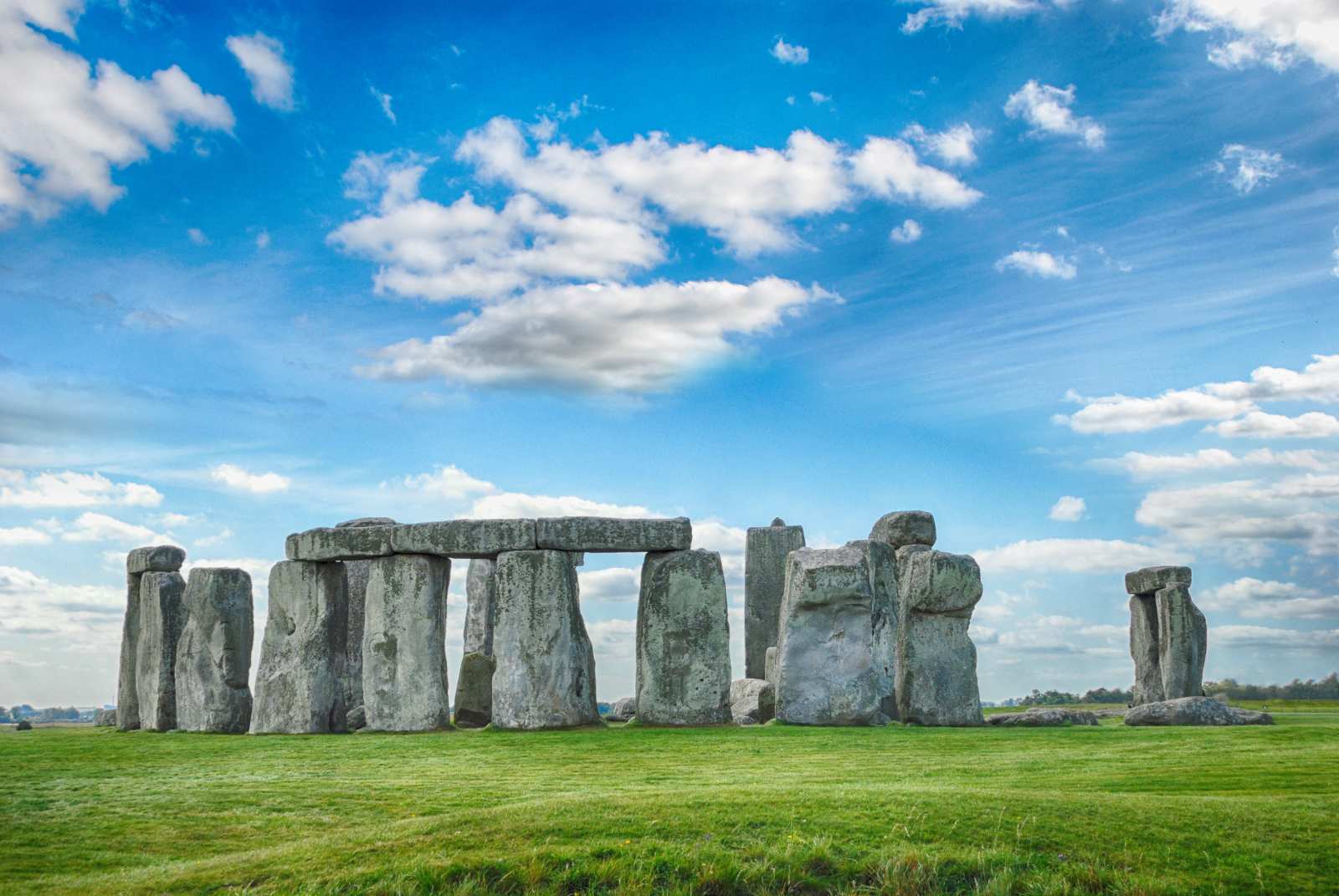
Development of Stonehenge
Stonehenge was constructed in several stages, beginning around 3100 BC with a circular earthwork and the Aubrey Holes, likely used for ceremonial purposes. The site was then left untouched for over a thousand years.
Around 2150 BC, builders transported about 82 bluestones from Wales, covering nearly 240 miles by land and water, and arranged them in an incomplete double circle. This stage also saw the widening of the entrance and the placement of heel stones.
By 2000 BC, large sarsen stones from marlborough downs were added, forming an outer circle and inner horseshoe. After 1500 BC, the bluestones were rearranged into the layout that remains visible today.
Why Visit Stonehenge?
Stonehenge remains one of the world’s most mysterious archaeological sites. Its unknown origins, possible role as a burial ground, and numerous legends continue to intrigue visitors.
The monument’s layout and alignment with solar events reflect the advanced understanding of space and time held by its builders. Visitors can observe how ancient communities marked important natural cycles.
At the visitor centre, nearly 300 exhibits, including artefacts and reconstructions, provide valuable insights. A visit offers both historical context and a deeper connection to one of Britain’s greatest landmarks.
Key Facts About Stonehenge
- Mysterious Construction
The exact method used to build Stonehenge remains unknown. Its creation predates the wheel, yet large stones were transported and precisely arranged. - Skilled Engineering.
Builders used mortise-and-tenon joints to secure lintels atop upright stones, demonstrating advanced construction techniques for the time. - Burial Site.
Archaeological finds confirm that Stonehenge served as a burial ground, possibly used for ceremonial or ancestral purposes. - Acoustic Design.
Studies show the original structure enhanced sound within the circle while limiting it from escaping, suggesting it hosted private rituals. - Solar Alignment.
During the summer solstice, sunrise aligns precisely with the heel stone, casting sunlight into the monument’s interior.
8. Big Ben
Standing adjacent to the Houses of Parliament, the clock tower known as the Elizabeth Tower remains one of the most distinguished features of London. Though commonly referred to as Big Ben, this name actually applies to the massive bell housed within the tower.
After the fire of 1834 that damaged the former Palace of Westminster, a new design was commissioned, which included a clock tower. The plans were developed by Edmund Beckett Denison and Sir George Airy, with Edward and Frederick Dent overseeing its construction. The bell currently in use was cast in Whitechapel in 1858 and first sounded the following year.
A crack developed shortly after it began ringing. To resolve this, engineers repositioned the bell and replaced the hammer. The sound that echoes from the tower today remains unchanged since that adjustment.
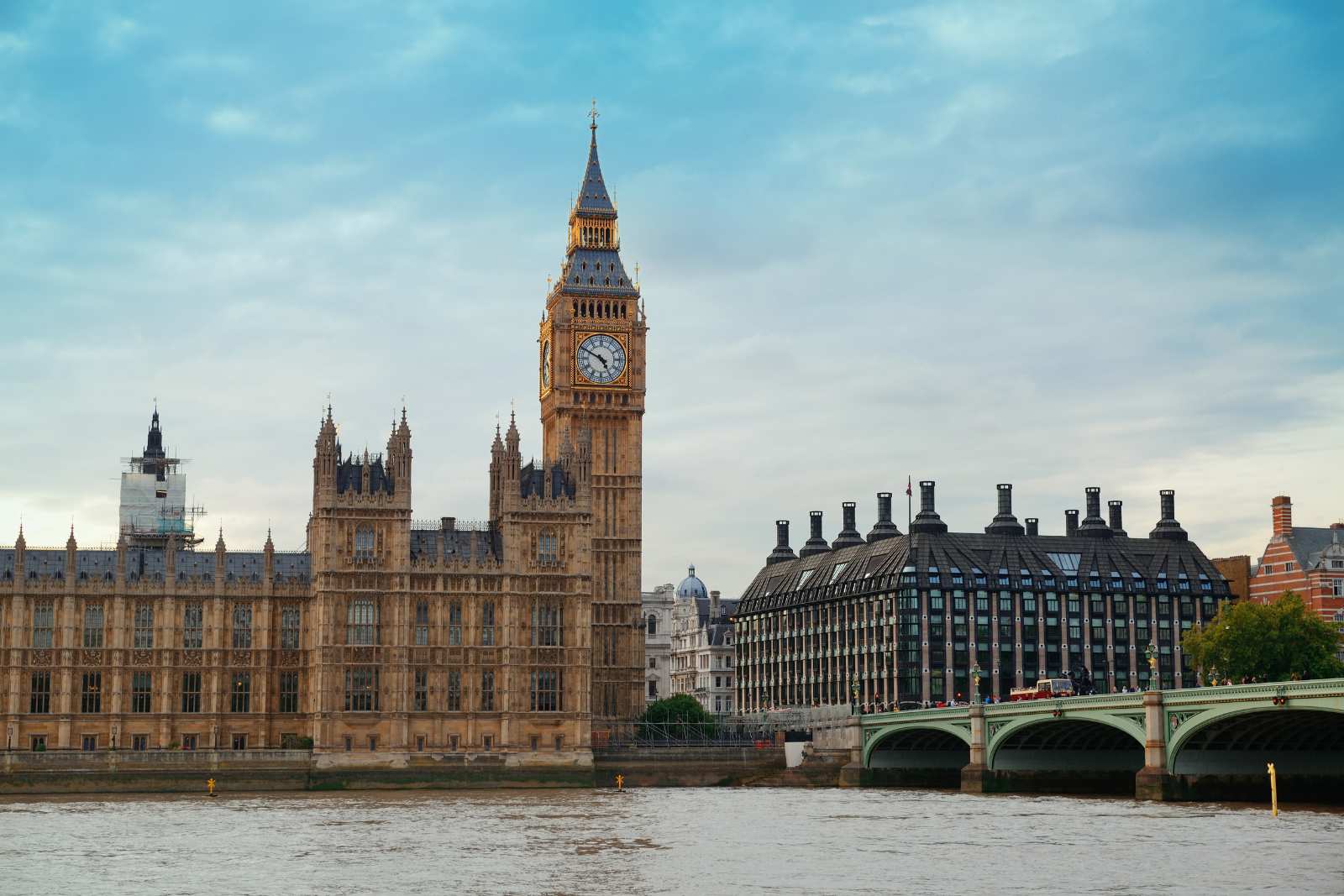
Big Ben: A Must-See in London
Rising above the banks of the River Thames, the Elizabeth Tower continues to be a defining landmark of London’s historic skyline. Its historic architecture, iconic chimes, and cultural significance make it a compelling site for any visitor.
The tower represents 19th century British design and has remained a central symbol of national identity. Located near major attractions like Westminster Abbey and the London Eye, it offers both historical depth and easy access for sightseeing.
Whether admired for its design, heard from across the Thames, or photographed at dusk, Big Ben remains a lasting emblem of Britain’s heritage.
Behind the Clock: Big Ben Facts
- Massive Clock Dials.
Each clock dial spans seven metres in diameter, making them among the largest of their kind in the world. - Impressive Minute Hands.
The minute hands extend 4.2 metres and weigh roughly 100 kilograms, including their counterweights. - Prominent Numerals.
The clock’s numbers are approximately 60 centimetres tall, contributing to their high visibility. - Hundreds of Glass Panels.
Each dial contains 312 pieces of glass, carefully fitted to complete the intricate design. - Parliament Light Signal.
A special light above the clock face is lit whenever parliament is in session. - Coin-Regulated Timekeeping.
Big Ben’s time accuracy is adjusted using coins placed on its pendulum—a traditional yet precise method. - Remarkable Continuity.
Even after the bombing of the commons chamber during World War II, the bell continued to strike without interruption. - Broadcasting Tradition.
The BBC first aired Big Ben’s chimes on 31st December 1923, and the broadcasts continue to this day. - Latin Inscription.
A latin phrase inscribed beneath the clock face translates to “O Lord, keep safe our Queen Victoria the First,” a tribute to the monarch under whose reign the tower was constructed. - Renamed in Honour of the Queen.
In June 2012, the tower was officially renamed the Elizabeth Tower to mark Queen Elizabeth II’s Diamond Jubilee. - Tower Height and Access.
The Elizabeth Tower stands over 96 metres tall, with 334 steps to the belfry and 399 steps to the Ayrton Light at its peak.
9. Lake District, England
The Lake District, located in Cumbria, England, is a renowned national park known for its scenic beauty and distinct geography. It spans 866 miles2 and includes England’s largest lake, Windermere, and highest mountain, Scafell Pike.
Its dome-like geological structure features hard pre-carboniferous rocks at the core and softer rocks to the north and south, shaping the region's varied terrain. Glacial activity further enhanced the landscape, carving valleys, forming lakes, and creating hanging waterfalls that add to its natural charm.

Discover Why the Lake District Captivates All
The Lake District combines serene landscapes, historic charm, and outdoor recreation, making it an ideal retreat for all ages. Whether you're exploring its vast walking paths or enjoying the peaceful atmosphere, the region offers a well-rounded escape.
Its location allows for convenient travel connections from various parts of the country, ensuring a smooth journey for visitors planning a countryside getaway.
Fascinating Facts About the Lake District
- UNESCO Recognition
The region is home to 2 sites recognised by UNESCO for their global cultural and historical value: the English Lake District and a section of the Roman Empire’s northern frontier. - England’s Largest National Park
It spans an area of 2,362 kilometres2, making it the largest national park in the country. - Home to England’s Highest Peak
Scafell Pike, England’s tallest mountain, is located within the Lake District. - Deepest Lake in England
Wastwater, reaching a depth of 74 metres, holds the title of the country’s deepest lake - Largest Lake by Surface Area
Windermere covers 14.8 kilometres2, making it the largest lake in England. - Inspiration for Literary and Artistic Giants
The Lake District inspired figures such as John Ruskin, William Wordsworth, and Beatrix Potter. - Largest Area of Common Land
The region contains 666 square kilometres of common land, the most in the UK. - Unique Naming of Lakes
Among 16 main bodies of water, only Bassenthwaite is officially called a “lake”; others are named meres or waters. - Native Herdwick Sheep
The area supports the Herdwick breed, a native sheep known for its resilience. - Record-Breaking Rainfall
Honister Pass saw 341.4 mm of rainfall in 24 hours during Storm Desmond in 2015. - Dense Inland Water Network
The region contains a remarkable 767.8 kilometres of inland waters. - Birthplace of Conservation Efforts
The Lake District played a central role in founding the National Trust and the conservation movement. - Vital Water Supply Source
The national park provides 40% of the daily drinking water for North West England.
10. Windsor Castle
Windsor Castle, located in Berkshire near the River Thames, rises above the surrounding landscape with its distinctive Round Tower. It consists of two main courtyards, the upper and lower wards, which are divided by this central feature.
Originally established by William the conqueror in the 11th century, the castle developed over time into a fortified royal residence. Successive monarchs expanded and adapted its design to serve both ceremonial and domestic functions.
Today, it remains an active royal residence and one of the most historically significant castles in Britain, with a continuous royal connection spanning over 9 centuries.
🏰 Windsor Castle Opening Times.
|
Period |
Opening Time 🕒 |
Last Admission 🕒 |
Closing Time🕒 |
|
1 November – 29 February |
10:00 AM |
3:00 PM |
4:15 PM |
|
1 March – 31 October |
10:00 AM |
4:00 PM |
5:15 PM |
❌ Closed on Tuesdays and Wednesdays
🕞 State Apartments close 30 minutes after last admission
🛑 Semi-State Rooms are closed until Autumn 2025
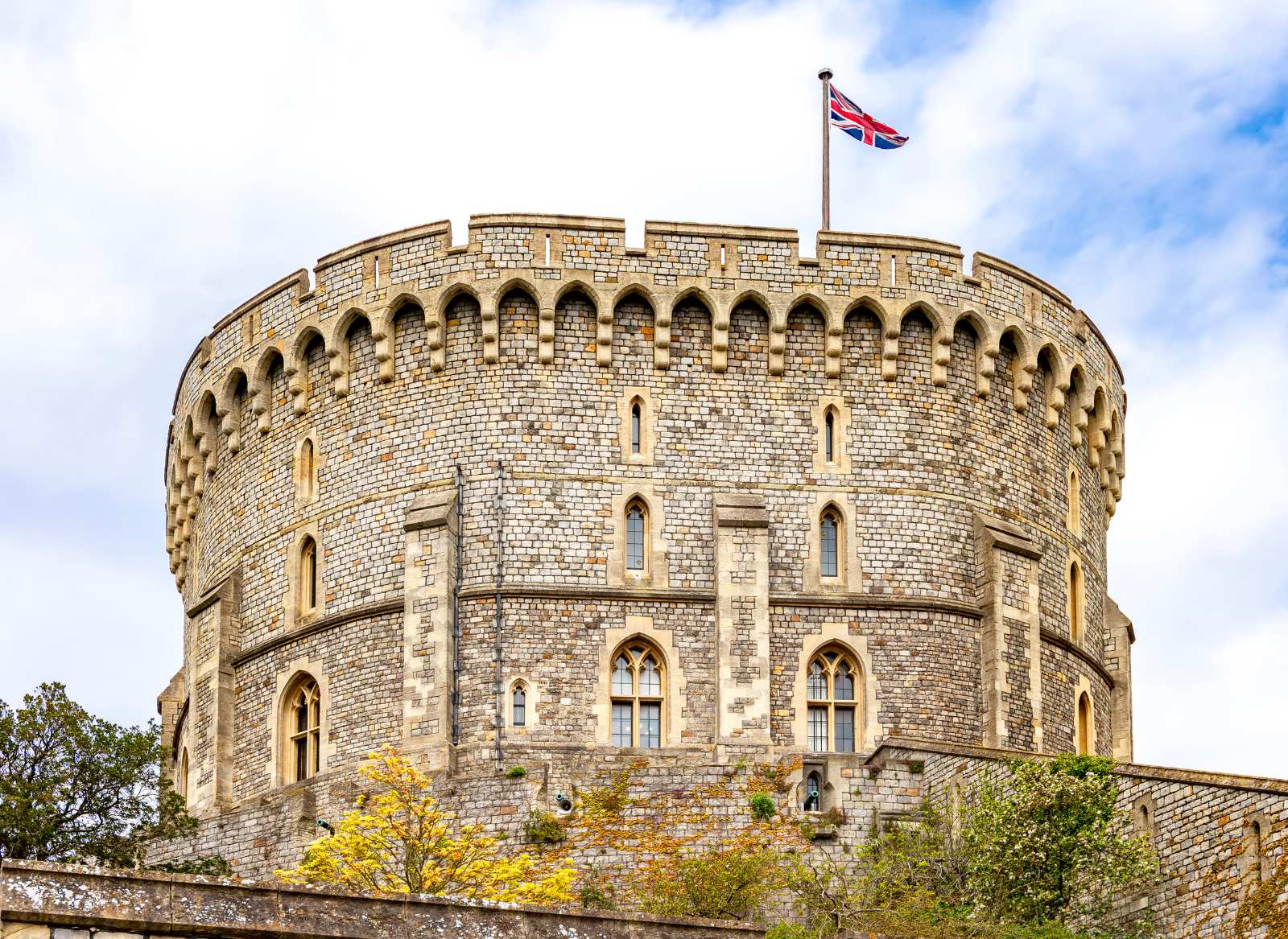
Highlights Inside Windsor Castle
Windsor Castle invites visitors to explore royal heritage through its elegant interiors and historic artefacts. The Grand Reception Room, adorned with gold and chandeliers, reflects ceremonial grandeur, while displays such as Queen Mary’s Dolls’ House and Henry VIII’s armour highlight royal craftsmanship.
The Castle houses an exceptional collection of paintings, including Van Dyck’s portrait of Charles I, alongside fine furniture and sculpture showcased throughout the state apartments.
Family-friendly features include interactive guides and dedicated learning areas, making Windsor Castle a year-round destination for all ages.
Windsor Castle: Notable Facts
- Oldest Inhabited Castle
William the Conqueror built Windsor Castle in the 11th century. Since Henry I's time, 39 monarchs have lived there. - Oldest Working Kitchen
The Great Kitchen has served meals since 1360 and remains in use today. - World War II Shelter
During WWII, Princesses Elizabeth and Margaret took refuge in the dungeons for safety. - Queen Elizabeth II’s Favourite
She spent her childhood at Windsor and used it as her weekend residence after 1952. - Fireplaces and Clocks
The castle has 300 fireplaces and nearly 450 clocks, all maintained by specialists. - Changing of the Guard
The ceremony occurs at 11:00 AM on tuesdays, thursdays, and saturdays - The Long Walk
This 4.5 km tree-lined avenue dates to the early 18th century. - Royal Family Name Origin
King George V adopted “Windsor” as the royal family name in 1917, replacing the previous name, which had German origins, in response to growing anti-German sentiment during World War I. - Royal Burials
Ten monarchs, including Charles I and Henry VIII, rest in St George’s Chapel.
Conclusion
The United Kingdom presents a rich blend of history, culture, and natural beauty. From ancient monuments to royal residences and world-class museums, each destination offers a distinct and memorable experience. With the UK ETA streamlining travel, exploring these iconic sites has never been easier.
Frequently Asked Question
- Is Buckingham Palace open to the public year-round?
No, the State Rooms at Buckingham Palace are only open from 10 July to 28 September 2025. Selected guided tours are also available from January to May 2025. - Can I visit more than one site in a single day?
It is possible to combine nearby attractions in major cities like London. For instance, one may visit Big Ben, Tower Bridge, and the British Museum within the same day, depending on travel pace and ticket availability. - How much time should I allocate to each site?
Time needed varies. For example, allow 3–4 hours for Windsor Castle or the British Museum, while Stonehenge or the Lake District may require a half or full day. Planning ahead ensures a more fulfilling visit. - Are there family-friendly facilities at these destinations?
Yes, many sites provide resources for families, such as interactive displays, child-focused tours, and learning centres. Windsor Castle, for example, offers child-friendly multimedia guides and educational zones.
Content Disclaimer: While this information reflects the latest update as of April 2025, we advise all travellers to confirm details with the relevant authorities, including official agencies, embassies, and airlines, to ensure full accuracy before making any travel arrangements.
Steps to Secure Your eTA for the United Kingdom
- Step1: Complete the online application form by entering your passport details and required personal information.
- Step2: Make the payment securely online using a credit or debit card.
- Step3: Check your email for the payment confirmation and receive your eTA electronically.
